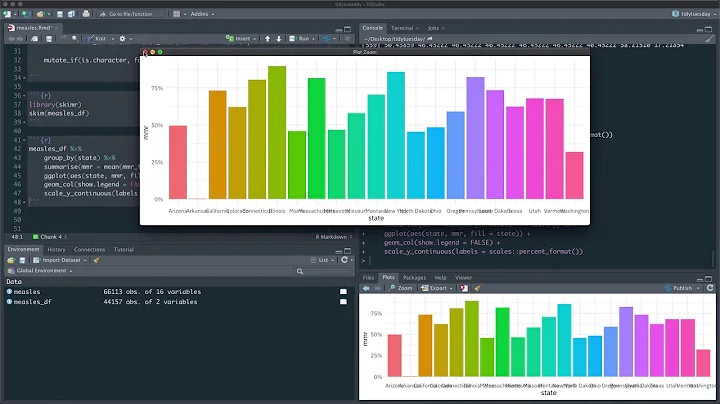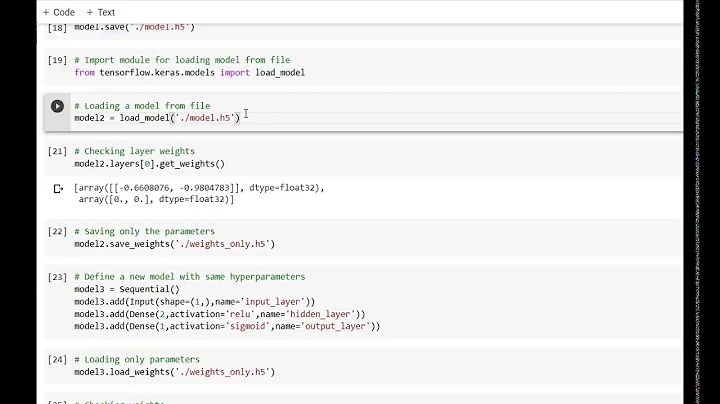model.summary() can't print output shape while using subclass model
Solution 1
I have used this method to solve this problem, I don't know if there is an easier way.
class subclass(Model):
def __init__(self):
...
def call(self, x):
...
def model(self):
x = Input(shape=(24, 24, 3))
return Model(inputs=[x], outputs=self.call(x))
if __name__ == '__main__':
sub = subclass()
sub.model().summary()
Solution 2
The way I solve the problem is very similar to what Elazar mensioned. Override the function summary() in the class subclass. Then you can directly call summary() while using model subclassing:
class subclass(Model):
def __init__(self):
...
def call(self, x):
...
def summary(self):
x = Input(shape=(24, 24, 3))
model = Model(inputs=[x], outputs=self.call(x))
return model.summary()
if __name__ == '__main__':
sub = subclass()
sub.summary()
Solution 3
I guess that key point is the _init_graph_network method in the class Network, which is the parent class of Model. _init_graph_network will be called if you specify the inputs and outputs arguments when calling __init__ method.
So there will be two possible methods:
- Manually calling the
_init_graph_networkmethod to build the graph of the model. - Reinitialize with the input layer and output.
and both methods need the input layer and output (required from self.call).
Now calling summary will give the exact output shape. However it would show the Input layer, which isn't a part of subclassing Model.
from tensorflow import keras
from tensorflow.keras import layers as klayers
class MLP(keras.Model):
def __init__(self, input_shape=(32), **kwargs):
super(MLP, self).__init__(**kwargs)
# Add input layer
self.input_layer = klayers.Input(input_shape)
self.dense_1 = klayers.Dense(64, activation='relu')
self.dense_2 = klayers.Dense(10)
# Get output layer with `call` method
self.out = self.call(self.input_layer)
# Reinitial
super(MLP, self).__init__(
inputs=self.input_layer,
outputs=self.out,
**kwargs)
def build(self):
# Initialize the graph
self._is_graph_network = True
self._init_graph_network(
inputs=self.input_layer,
outputs=self.out
)
def call(self, inputs):
x = self.dense_1(inputs)
return self.dense_2(x)
if __name__ == '__main__':
mlp = MLP(16)
mlp.summary()
The output will be:
Model: "mlp_1"
_________________________________________________________________
Layer (type) Output Shape Param #
=================================================================
input_1 (InputLayer) [(None, 16)] 0
_________________________________________________________________
dense (Dense) (None, 64) 1088
_________________________________________________________________
dense_1 (Dense) (None, 10) 650
=================================================================
Total params: 1,738
Trainable params: 1,738
Non-trainable params: 0
_________________________________________________________________
Solution 4
I analyzed the answer of Adi Shumely:
- Adding an Input_shape should not be needed since you set it in the build() as a parameter
- Adding an Input layer does nothing to the model and it is brought as a parameter to the call() method
- Adding the so-called output is not the way I see it. The only, and most important, thing that it does is calling the call() method.
So I bring it up and come up with this solution that does not need any modification in the model and just needs to improve the model as it is built before the call to the summary() method by adding a call to the call() method of the model with an Input tensor. I tried on my own model and on the three models presented in this feed and it works so far.
From the first post of this feed:
import tensorflow as tf
from tensorflow.keras import Input, layers, Model
class subclass(Model):
def __init__(self):
super(subclass, self).__init__()
self.conv = layers.Conv2D(28, 3, strides=1)
def call(self, x):
return self.conv(x)
if __name__ == '__main__':
sub = subclass()
sub.build(input_shape=(None, 24, 24, 3))
# Adding this call to the call() method solves it all
sub.call(Input(shape=(24, 24, 3)))
# And the summary() outputs all the information
sub.summary()
From the second post of the feed
from tensorflow import keras
from tensorflow.keras import layers as klayers
class MLP(keras.Model):
def __init__(self, **kwargs):
super(MLP, self).__init__(**kwargs)
self.dense_1 = klayers.Dense(64, activation='relu')
self.dense_2 = klayers.Dense(10)
def call(self, inputs):
x = self.dense_1(inputs)
return self.dense_2(x)
if __name__ == '__main__':
mlp = MLP()
mlp.build(input_shape=(None, 16))
mlp.call(klayers.Input(shape=(16)))
mlp.summary()
As from the last post of the feed
import tensorflow as tf
class MyModel(tf.keras.Model):
def __init__(self, **kwargs):
super(MyModel, self).__init__(**kwargs)
self.dense10 = tf.keras.layers.Dense(10, activation=tf.keras.activations.softmax)
self.dense20 = tf.keras.layers.Dense(20, activation=tf.keras.activations.softmax)
def call(self, inputs):
x = self.dense10(inputs)
y_pred = self.dense20(x)
return y_pred
model = MyModel()
model.build(input_shape = (None, 32, 32, 1))
model.call(tf.keras.layers.Input(shape = (32, 32, 1)))
model.summary()
Solution 5
had the same problem - fix it by 3 steps:
- add input_shape in the _ init _
- add a input_layer
- add out layer
class MyModel(tf.keras.Model):
def __init__(self,input_shape=(32,32,1), **kwargs):
super(MyModel, self).__init__(**kwargs)
self.input_layer = tf.keras.layers.Input(input_shape)
self.dense10 = tf.keras.layers.Dense(10, activation=tf.keras.activations.softmax)
self.dense20 = tf.keras.layers.Dense(20, activation=tf.keras.activations.softmax)
self.out = self.call(self.input_layer)
def call(self, inputs):
x = self.dense10(inputs)
y_pred = self.dense20(x)
return y_pred
model = MyModel()
model(x_test[:99])
print('x_test[:99].shape:',x_test[:10].shape)
model.summary()
output:
x_test[:99].shape: (99, 32, 32, 1)
Model: "my_model_32"
_________________________________________________________________
Layer (type) Output Shape Param #
=================================================================
dense_79 (Dense) (None, 32, 32, 10) 20
_________________________________________________________________
dense_80 (Dense) (None, 32, 32, 20) 220
=================================================================
Total params: 240
Trainable params: 240
Non-trainable params: 0
Related videos on Youtube
Gary
Updated on January 28, 2022Comments
-
Gary about 2 years
This is the two methods for creating a keras model, but the
output shapesof the summary results of the two methods are different. Obviously, the former prints more information and makes it easier to check the correctness of the network.import tensorflow as tf from tensorflow.keras import Input, layers, Model class subclass(Model): def __init__(self): super(subclass, self).__init__() self.conv = layers.Conv2D(28, 3, strides=1) def call(self, x): return self.conv(x) def func_api(): x = Input(shape=(24, 24, 3)) y = layers.Conv2D(28, 3, strides=1)(x) return Model(inputs=[x], outputs=[y]) if __name__ == '__main__': func = func_api() func.summary() sub = subclass() sub.build(input_shape=(None, 24, 24, 3)) sub.summary()output:
_________________________________________________________________ Layer (type) Output Shape Param # ================================================================= input_1 (InputLayer) (None, 24, 24, 3) 0 _________________________________________________________________ conv2d (Conv2D) (None, 22, 22, 28) 784 ================================================================= Total params: 784 Trainable params: 784 Non-trainable params: 0 _________________________________________________________________ _________________________________________________________________ Layer (type) Output Shape Param # ================================================================= conv2d_1 (Conv2D) multiple 784 ================================================================= Total params: 784 Trainable params: 784 Non-trainable params: 0 _________________________________________________________________So, how should I use the subclass method to get the
output shapeat the summary()? -
 Gilfoyle over 3 yearsCan you explain why this works? Especially the
Gilfoyle over 3 yearsCan you explain why this works? Especially theoutputs=self.call(x)part. -
Rob Hall over 3 years@Samuel By evaluating
outputs=self.call(x), thesubclass.call(self, x)method is invoked. This triggers shape computation in the encapsulating instance. Furthermore, the returned instance ofModelalso computes its own shape which is reported in.summary(). The primary problem with this approach is that the input shape is constantshape=(24, 24, 3), so if you need a dynamic solution, this won't work. -
GuySoft about 3 yearsCan you explain what goes in the
.... Is this a general solution or do you need model-specific stuff in those calls? -
 DeWil almost 3 years@GuySoft ... in init instantiates your layers while ... in call connects the different layers building a network. It's generic for all subclassed keras models.
DeWil almost 3 years@GuySoft ... in init instantiates your layers while ... in call connects the different layers building a network. It's generic for all subclassed keras models. -
MOON about 2 yearsAre there any advantage over the Elazar's solution? I like your approach since it is more succinct.











